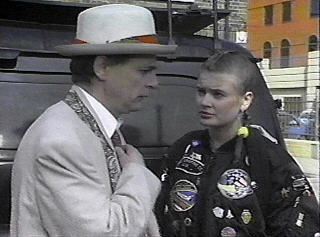
Sylvester McCoy1987-1989
Companions: Melanie "Mel" Bush (Bonny Langford), Dorothy "Ace" (last name unknown although there's a suggestion that the producers wanted it to be Gale) (Sophie Aldred)
Comments: Born James Kent-Smith in Scotland in 1943 and raised in Dublin Ireland by his mother and grandmother (his father died in World War II, shortly before he was born). Between the ages of 12 and 16 he studied for the priesthood and actually applied to enter a Dominican Monastery but was rejected because he was too young. He soon discovered girls and thoughts of a religious life vanished. At various times he worked as an insurance salesman and was once a bodyguard for the Rolling Stones. He entered show business first at age 27 selling tickets and keeping the books for a theater. Later he joined the "Ken Campbell Roadshow" where he had a double act with a young man named Bob Hoskins. After Hoskins left the show, Kent-Smith developed a comedy act as a circus stuntman who did things like stuffing ferrets down his pants (!) - the name of the stuntman was Sylvester McCoy and as a joke Sylvester McCoy was billed as being played by Sylvester McCoy. A critic didn't get the joke and liking the irony of the situation, James Kent-Smith adopted Sylvester McCoy as his stage name.
McCoy was primarily a stage actor with some credits in children's television when he was selected to play The Doctor by John Nathan-Turner. In fact he is the only actor to play two different Doctors on the show. Since Colin Baker refused to sign on to play the Sixth Doctor for the regeneration scene, McCoy put on a curly blonde wig and Baker's trademark multi-colored coat and was photographed laying on his stomach so that his face wasn't seen during the regeneration scene. McCoy's Doctor was far more subdued than Colin Baker's both in dress and personality. Normally dressed in a straw hat, off-white jacket, a sweater vest decorated with question marks over a white shirt and tie, and tweed trousers with a sort of Scottish plaid feel to them, his biggest affectation was the umbrella he always carried which had a question mark handle. In terms of personality he was very much a toned down throwback to Patrick Troughton's version of The Doctor - comedic but with an added, philosophical aspect to his character. Another aspect that the writers were beginning to explore was the notion that The Doctor was more than "just" a Time Lord; there was something deeper going on.
In terms of Companions, Mel remained pretty much as she had been in the two serials she did with Colin Baker, namely a screamer as well as a health food activist. The problem is that the scripts didn't give much opportunity for development. Ace fared much better. In fact her character was developed more than any other companion with much of what turned out to be the final season of the original series being devoted to her character. She was a rebellious teen with a bad relationship with her mother, a love of explosives, and a hatred of racism caused by the death of a childhood friend in a racially inspired attack. Over time she became increasingly confident and less brash.
The scripts for McCoy's first season were quite weak, a result of the turmoil that surrounded John Nathan-Turner's relationship with the previous script editor. There was no time for the new script editor, Andrew Cartmel, to put his stamp on the twenty-fourth season - McCoy's first - and scripts previously accumulated on the "slush pile" were used for the season. To say the least they were uneven. The next season was the show's twenty-fifth anniversary. It contained an uneven Cybermen story, and a beautifully realized Dalek story taking place at Coal Hill School (where Ian and Barbara had taught Susan) climaxing on November 23, 1963 - the day that Doctor Who premiered on BBC TV. Even one of the silliest episodes The Happiness Patrol was deeper than many people thought. At the very least is it was an anti-fascist tale and could very readily be seen as a parody of Margaret Thatcher's Britain, although the murderous robot made to resemble a collection of licorice allsorts tended to undercut things. The Greatest Show In The Galaxy serial has been analysed as being a parody of the BBC and it's management with the "Gods of Ragnorok" representing the TV audience which is always seeking some new entertainment. The twenty-sixth, and as it turned out the final season of the series not only featured the aforementioned arc devoted to Ace, which also continued to show The Doctor as a master manipulator, but also an appearance by Lethbridge-Stewart (who never did appear with the Sixth Doctor - at least not on television) and Anthony Ainley's final appearance as The Master.
Sadly the changes weren't enough. The BBC had already moved the show away from its traditional Saturday afternoon time slot, moving it first to Monday and then to Wednesday for the final two seasons and the ratings had not improved. Nathan-Turner was thoroughly tired and wasn't prepared to put up the same sort of fight that he had when Michael Grade had cancelled the show (Grade had left the BBC in 1988) so he simply packed up his office while McCoy and Aldred were informed they were unemployed. McCoy recorded a final monologue and that was it.
Or was it?
1 comment:
Is it me or were they thinkin'Tom Wolfe when they conceived McCoy's Doctor Who look?
Post a Comment